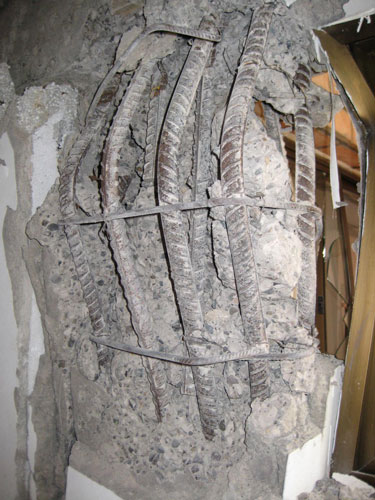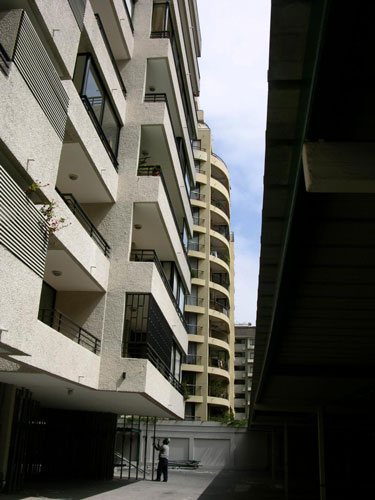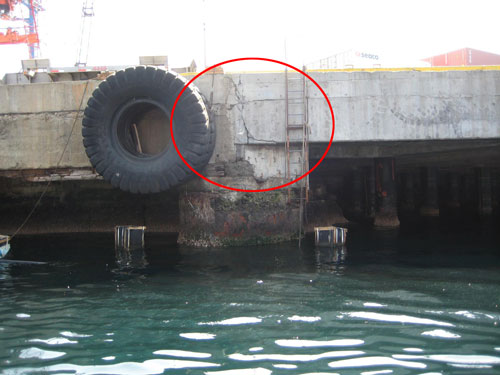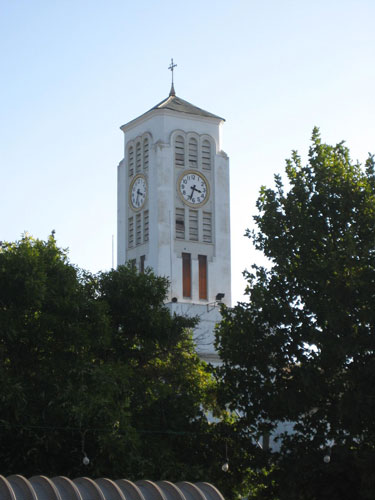Chile Earthquake
Status: Closed
Update 5 | Summary
Posting Date: March 17, 2010, 8:27:00 AM
This report is the second in a series from AIR's ongoing damage survey in regions of Chile impacted by an M 8.8 earthquake that struck off the country's coast on February 27. The photos and commentary here offer an initial glimpse into the kinds of damage patterns caused by this event.
In this report, Drs. Guillermo Franco and Tao Lai and Engineer Guillermo Leiva provide commentary from the Chilean coastal cities of Valparaíso and Viña del Mar, as well as the small town of Casablanca.

Figure 1: This map shows the three cities—(A) Viña del Mar, (B) Valparaíso, and (C) Casablanca—visited on this leg of the AIR team's damage survey in Chile. (Source: Google Earth).
Viña del Mar
Viña del Mar—Chile's fourth largest city—is a commune in the Valparaíso Region. It has grown enormously in the last 10 years; many high-rise concrete apartment buildings dot its skyline and consequently, it has a high concentration of valuable exposure. AIR's survey team observed broken windows in Viña del Mar's high-rise structures, as well as damage to non-structural components (for example, brick veneers and store fronts) throughout the city.
Structural damage in Viña del Mar was limited and, as in Santiago, largely confined to relatively small pockets within the city. In one such neighborhood, the buildings were typically high-rise structures of reinforced concrete built ten or fifteen years ago—though a few were much more recent. The low-rise and mid-rise residential structures in this neighborhood were not visibly damaged.
Owners of many of the buildings in the neighborhood were present; sometimes they granted AIR's team access and sometimes—because of ongoing litigation processes—they did not. From the street, the team observed general failures such as damage to first-story walls, balconies, and walls beneath windows, as well as damage to non-structural elements.
The team entered the building pictured below, which had suffered a partial collapse. Two of the building's structural walls failed in shear, causing a 10-centimeter vertical displacement. The whole wall segment pictured in Figure 2 exhibited severe tilt.

Figure 2: Partial collapse of high-rise apartment building in Viña del Mar (Source: AIR).
Inside the building, the team noticed severe cracking in the walls of the apartment unit they examined, as well as deformation of the slab and cracking of the stairwell. Figure 3 shows the interior side of one of the building's structural walls; compression might have caused both the failure of this wall section and the subsequent buckling of the longitudinal rebar.

Figure 3: Buckled longitudinal rebar in structural wall of Viña del Mar building (Source: AIR).
Consistent with reports the survey team collected from Santiago, the residents of this Viña del Mar apartment building who had a mortgage were indeed insured against earthquake damage. However, the residents who had paid in full (and therefore had no mortgage) and had not bought a personal earthquake policy were not protected. The common areas, such as stairs, gyms or pools, are typically insured by a condo association policy.
At the nearby Toledo Building in Viña del Mar, another high-rise structure, AIR's survey team observed construction workers shoring up overhangs to try to avoid further deformations; the building already showed a very severe tilt in the direction of the parking area. The tilt is visible in Figure 4 in comparison with the building behind.

Figure 4: Tilting Toledo Building in Viña del Mar (Source: AIR).
During the earthquake, the building experienced rocking, which caused stress to the shear wall system. All the shear walls in the back underwent compression failure (circled in Figure 5). The back of the building—which, again, serves as a parking area—has fewer walls in order to allow for the maneuvering of automobiles. Therefore, it has a smaller capacity to resist earthquake loads. Figure 6 shows details of the compression failures of these walls. The survey team noted that they were not sufficiently wide.

Figure 5: Shear walls in the back of the Toledo Building underwent compression failure (Source: AIR).

Figure 6: Details of the compression failure in the walls of the Toledo Building, including buckling of the longitudinal rebar (right) (Source: AIR).
The opposite side of the Toledo Building showed tension failure, as evidenced by the horizontal cracks and the longitudinal rebar intact—without any signs of buckling.

Figure 7: Tension failure in an outer wall of the Toledo Building (Source: AIR).
Valparaíso
Valparaíso is one of Chile's most important seaports. The port did not suffer significant structural damage during the earthquake. Its main cranes were operating, and loading of container ships was continuing as usual on the day of the team's visit. One sidewalk, having suffered a 10 to 15-centimeter settlement, was closed to the public. There were no reports of tsunami and the survey team found no tsunami-related damage.
The image below shows a piling structure at the city's port. The survey team observed cracking along one of the structure's construction joints, but it was not possible to confirm whether this crack was due to the recent earthquake.

Figure 8: Cracking along a construction joint of a piling structure at Valparaiso's main port (Source: AIR).
Beyond the port, in the city of Valparaíso, damage to the structures was negligible. Exposure is dominated by historical buildings, many of which are masonry. Even before the earthquake, these structures were in a dubious state of repair, which made it difficult to judge whether some of the visible cracks in these buildings were due to the February 27th earthquake.
In the hills of Valparaíso, large areas are settled; the exposure here is mainly confined masonry with either wood veneer or metal sheet veneer (Figure 9). In general, even these humble buildings performed well during the earthquake—with only some reported failures, primarily of adobe walls of residences in very poor neighborhoods. No significant structural damages were reported in concrete buildings.

Figure 9: Typical settlements in the hills of Valparaiso performed well (Source: AIR).
Casablanca
The survey team also visited Casablanca—a small town about 50 kilometers south of Valparaíso, en route to Santiago. According to the Carabineros, the local police, the town had experienced almost no damage. Only a couple adobe walls had cracked, but the buildings in which this damage occurred were in a state of disrepair anyway, waiting to be demolished for the expansion of a local supermarket. The clock of the local church still showed the time of the earthquake (Figure 10).

Figure 10: The clock in Casablanca still shows the time of the 2/27 earthquake. (Source: AIR).
The Fate of Damaged Buildings
As noted in yesterday's report, the question of whether or not to demolish several of the damaged buildings—particularly those mid- and high-rise buildings whose ground story shear walls have experienced failure—is currently very contentious. Rumors about retrofits, shoring, and other approaches persist, but whether such efforts will succeed remains to be seen. However, demolition, if chosen, presents its own difficulties; officials have told AIR that Chile lacks the technology to demolish high-rise buildings in dense urban settings.
Earlier this week, AIR's damage survey team met with an urban planning consultant employed by the government. The consultant is in charge of the first pilot project for reconstruction in Chile. The team also attended lectures on the identified shortcomings of the Chilean building code given by well-known Chilean professors, Drs. Saragoni and Riddell.
On Sunday, March 14, the team experienced a widespread blackout. The central region of the country is served by a single network called "Interconectado Central." It lost many of its redundancy systems after the earthquake. One 500-watt transformer in the Temuco area, about 700 kilometers south of Santiago, failed, causing the whole system to come down Sunday night.
AIR's survey team in Chile is continuing to survey various regions impacted by the February 27th earthquake—including Concepción—and ALERT subscribers will be notified when additional damage survey reports are posted to the ALERT website. The AIR earthquake team will continue to review the available information and provide updates as warranted.